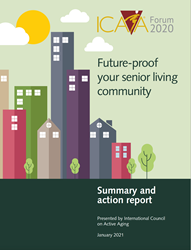
ICAA Forum Report, Future-proof your senior living community
“The upside of the COVID-19 pandemic for senior living is the opportunity to truly reinvent the product to one that will appeal to the younger older adults who are future residents, and expand beyond the small percent of older adults who now choose their combination of housing and services.”
VANCOUVER, British Columbia (PRWEB)
January 19, 2021
The extraordinary efforts made by the staff and leadership in senior living communities were successful in keeping many older adult residents safe and healthy. While the fundamental services offered in independent living, assisted living and memory care continued to be provided, by the end of 2020, leaders in senior living were imagining the optimal community that offers the lifestyle and services current residents desire, and the quality-of-life future residents will seek.
More than 85 thought leaders joined together at the International Council on Active Aging Forum in November 2020 to future-proof the industry by identifying a philosophy and infrastructure to withstand the stresses that impact operations. Former competitors became allies as they shared ideas and focused on the elements that construct a resilient community.
Five future-proof trends recap the major themes that will direct the next normal of senior living.
1. Redefine the meaning of “community.” Repositioning the senior living community as an accessible neighborhood within the larger community provides sustainability by making it easier to expand services to older adults residing off the property, and to open on-property services and amenities to nonresidents. Providing affordable housing for staff and their families is an option that helps solve staffing challenges for the community and economic challenges for staff.
2. Expand the built and unbuilt environment. The outdoor features of sidewalks, gardens, paths and nearby parks and recreation become equal in importance to the indoor spaces, redesigned to allow for quick resets depending on purpose. Large and small spaces with moveable walls and “tiny house” features like flip-up table tops build in flexibility. Purpose-built virtual health care locations are designed for technology and privacy. Patios and balconies are accessible places for active and passive pursuits.
3. Integrate technology through all operations. Future demand means internet connections, software and hardware are available in all areas of a building, as well as outdoors. Tech-enabled spaces will be used by upskilled staff and residents who have easy access to training and troubleshooting. Personal technologies, such as activity trackers and heart rate monitors, will be widely used, and rooms equipped with smart utilities, remote monitoring, voice-activated systems and in-house channels will be embedded in living and service areas.
4. Strengthen workforce quality, growth and retention. Along with updated recognition of the importance of frontline staff to the existence of senior living comes compensation-building benefits that might include access to on-site health care, dining and other amenities. Well-defined career paths from frontline to other roles, and serious professional development opportunities beyond those required by regulations, build the quality workforce. Flexible work schedules and options for affordable housing near or on the property relieve staff turnover while providing safety for residents by reducing travel time and need for second jobs.
5. Emphasize wellness culture and lifestyle. Wellness is the philosophy that guides the actions of everyone in all areas of a community. Woven into all areas of the residents’ lives, wellness in all the dimensions is the sales pitch that invites new residents and the lifestyle that retains them (remember that health care is a component of the physical dimension of wellness). A hybrid model combining virtual with in-person opportunities uses the technologies pervasive throughout the community.
“The visions created by the industry thought leaders are ambitious, innovative and inspiring,” says Colin Milner, founder and CEO of the International Council on Active Aging. “The upside of the COVID-19 pandemic for senior living is the opportunity to truly reinvent the product to one that will appeal to the younger older adults who are future residents, and expand beyond the small percent of older adults who now choose their combination of housing and services.”
Full details of these trends are found in the ICAA Forum report, “Future-proof your senior living community.” You can download it at https://www.icaa.cc//listing.php?type=white_papers
Baseline strategies and tactics are captured in “Creating a path towards the ‘next normal’ in senior living,” the results of the ICAA COVID-19 Senior Living Task Force held in May 2020. You can download it at https://www.icaa.cc//listing.php?type=white_papers
The ICAA Forum was sponsored by Humana, NuStep, Delos Labs, Keiser, Matrix, iN2L, LiveBrite Today, Merrithew, Morrison Living
About the ICAA Forum
https://www.icaa.cc/conferenceandevents/forums.htm
The ICAA Forum brings together thought leaders from many organizations—both private and public—to form a think tank that develops strategies to turn the challenges facing senior living providers into opportunities. Launched in 2005, the meetings forge connections among industry leaders while promoting understanding and cohesive action around the ultimate goal: health and quality of life as people age.
Organizer: Colin Milner, CEO, International Council on Active Aging, colinmilner@icaa.cc
About the International Council on Active Aging (ICAA)
http://www.icaa.cc
ICAA is a professional association that leads, connects and defines the active-aging industry and supports professionals who aspire to develop wellness cultures for adults over 50. This support includes creating wellness environments, programs and services. The association is focused on active aging—an approach to aging that helps older adults live life as fully as possible within all dimensions of wellness—and provides its members with education, information, resources and tools. As an active-aging educator and advocate, ICAA has advised numerous organizations and governmental bodies, including the US Administration on Aging, the National Institute on Aging (one of the US National Institutes of Health), the US Department of Health and Human Services, Canada’s Special Senate Committee on Aging, and the British Columbia (Canada) Ministries of Health and Healthy Living and Sport.
Share article on social media or email:

